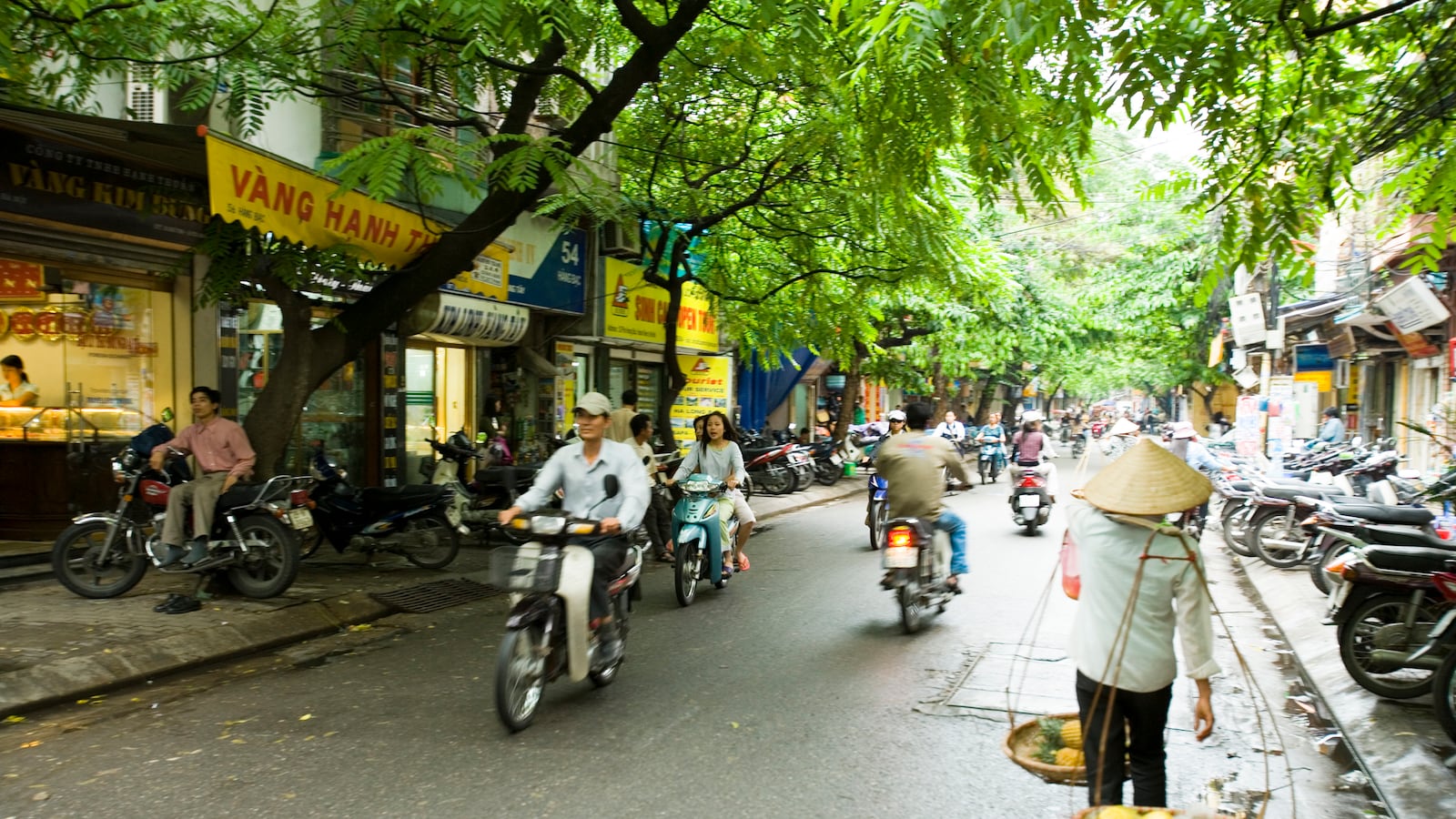Just after dawn on a brisk December morning, my wife and I stepped out of the Metropole Hotel in Hanoi for our first look at the capital of Vietnam. We didn’t know what to expect; perhaps clusters of folks in the midst of Tai Chi exercises, as loudspeakers blared official Party news about higher rice production. What we did not expect was the sight of dozens of older women, gathered in a small park just east of Hoan Kiem Lake, dancing the Lindy Hop to American tunes from the early ’60s, while dozens more close by the lake were Texas line-dancing.

As my wife and I joined in the dancing—an effective remedy, we discovered, for jet lag—an elderly woman walked up to us, and asked: “American?” When we nodded, she broke into a wide grin, gestured with two thumbs up, and finished off with a high-five.
It was an appropriate opening experience. Nearly 40 years after the last Americans fled Saigon as North Vietnamese tanks rolled up to the presidential palace, nearly 20 years after the United States and Vietnam opened embassies in each other’s countries, a tourist so inclined could visit Vietnam and never confront any sign of a war that cost the lives of more than 58,000 Americans—and more than two million Vietnamese. The country has become a powerful tourist magnet, last year, more than seven and a half million tourists visited Vietnam, more than 430,000 of them Americans. Most come for the beaches, jungles, hiking paths, luxury resorts, and the temples of neighboring Cambodia. If you wander the streets of Hanoi and Saigon—most locals ignore the “Ho Chi Minh” name the way New Yorkers don’t call Sixth Avenue “The Avenue of the Americas”—if you look at the explosion of hotels and apartments, the Bulgari, Chanel, Dolce e Gabbana offerings along Le Loi Street; if you drive the coastal route South of Da Nang and glimpse the luxury hotels (and a casino) that line the coast; if you cruise down the Mekong on a luxury river boat, with visits by motor launch to pastoral villages, you may find yourself asking, “Is this the place that saw so much death and destruction? Is this the place that tore our nation apart for so long?
In fact, for all the beauty of its beaches, the pastoral tranquility of its fishing villages and coasts, that war is really never far away. And if you’re an American of a certain age, it turns out that if you come to Vietnam … you bring your own Vietnam with you.
* * *
We were outside Ho Chi Minh’s mausoleum, a Soviet-style 71-foot-high monument, built in express contradiction of Ho’s wish for a simple cremation. (There is no other place on earth where an American could go to visit the resting place of a leader whose nation had defeated the world’s mightiest military power.) When Dragon—the anglicized name of our guide—learned that I had worked in Robert Kennedy’s 1968 campaign, and had been a political journalist, he asked if we’d like to see something off the beaten path—“a place I don’t usually offer to Americans.” A short walk down Hoang Hoa Tham Street brought us to a narrow alley, filled with street vendors, stalls, and motorcycles, from which we emerged next to a tiny lake—a pond, really. In the lake, where it had rested for more than 40 years, was the wreckage of a downed American B-52.
If you want to kindle the memories of the war, you will find such reminders everywhere—even in the unlikeliest of places. A walk back to our hotel from a Buddhist temple brought us to Truc Bach Lake—where a large plaque commemorates the downing of Navy Lt. Commander John McCain on October 26, 1967. If you visit Hanoi Towers, a 48 story high-rise with luxury hotel apartments, shops, and restaurants, you find that the building casts its shadow—literally—over the courtyard of what was Hoa Lo Prison—the “Hanoi Hilton” where McCain and other American prisoners of war were kept. When we took a private cooking class in Saigon, we were brought to a home that had been the residence of Henry Cabot Lodge, the U.S. ambassador, where he helped engineer the 1963 coup that deposed (and murdered) South Vietnam President Ngo Dinh Diem—a coup that helped lead the United States into a full-scale military commitment.
There are also ways to measure Vietnam’s attitude toward its one-time enemy. The Hanoi Hilton museum is filled with artifacts of the atrocities commuted by the French when they used the prison to incarcerate Vietnamese fighters; everywhere there are shackles, photos of inhuman confinement—even a guillotine. By contrast, the era of American POWs offers photos of Christmas parties and volleyball in the courtyard. Even where pictures of the suffering of Vietnamese civilians at American hands abound, there is an implicit reminder of what has changed since the war ended. In what once was the Saigon headquarters of the U.S. Information Agency, a large museum tells the official story of the war. American military weaponry, from tanks to Huey helicopters, fill the courtyard; inside are pictures of dead women and children, the horrific consequences of napalm and Agent Orange, worldwide protests against U.S. involvement. (Because history is written by the winners, there are no photos of re-education camps, imprisoned dissidents, or fleeing refugees).
As for the measure of changing attitudes, just look at the name of the museum. When it opened in 1975, a few months after the reunification, it was called the "Exhibition House for US and Puppet Crimes.” Fifteen years later, it was renamed “Exhibition House for Crimes of War and Aggression.” In 1995, when relations between the U.S. and Vietnam were “normalized,” and the U.S. trade embargo was dropped, the building became the "War Remnants Museum.” No mention of the United States; no reference to “war crimes.”
Of all that we saw in Vietnam, nothing was more head-spinning than a visit to the Cu Chi tunnels, a two-hour drive northwest of Saigon. The tunnel complex, originally built in 1948 when the Viet Minh were battling their French colonial occupiers, was an astonishingly complex system; men, weapons, food, communications all moved through the tunnels; Viet Cong guerrillas were housed, healed, fed underground. It was a key reason why the half million U.S. soldiers and massive bomb tonnage could not achieve decisive military victory.
And today? It’s kind of like … Disneyland.
Tour buses and private cars fill the parking lots; guides invite you to crawl through the narrow tunnels; others, dressed in military dress, demonstrate the many different booby-traps hidden underground to ensnare American soldiers, impaling them on punji sticks or nails. As the devices are demonstrated, the audience breaks into applause, as if watching a ginsu knife demonstration at a state fair. A mile and a half from the tunnels, there’s a shooting range where—for a fee of about $1.75 a bullet, you can shoot a choice of weapons including the AK-47, the M16, or a 30 Caliber machine gun. You exit, of course, through the gift shop.
* * *
Maybe that’s an oddly appropriate experience for me—someone for whom Vietnam was a both a personal and political issue for so much of my life. In 1962, when I was 19 and editor of the University of Wisconsin Daily Cardinal, I wrote a skeptical editorial asking what 15,000 American “advisors” were doing in South Vietnam. As a law student, I participated in the first “teach-ins” about the war. As a Senate and campaign aide to Robert Kennedy, I was a small cog in an effort to elect a president who would stop that war; as a staffer for New York Mayor John Lindsay, I spoke at events during a day long “Vietnam moratorium.” And it was those academic and vocational connections that got me deferments from the military; a consequence of the kind of privilege James Fallows wrote so brilliantly about in his classic essay, “What Did You Do in the Class War, Daddy?”
And through the next four decades-plus, as a political operative and then as a journalist, I saw Vietnam refracted in virtually every presidential campaign: McGovern’s doomed peace campaign of 1972; Jimmy Carter’s promise of presidential pardons for draft resisters in 1976; Ronald Reagan’s assertion that Vietnam was a “noble cause” in 1980; George H.W. Bush’s visits to flag factories as a way of questioning the patriotic fervor of his foe in 1988; the questions of evading the draft or military obligations that stalked Bill Clinton and then George W. Bush; the nomination of two candidates defined in good measure by their service in Vietnam: John McCain and John Kerry (and the campaign to discredit Kerry’s service that brought a new phrase—“swift boating”—into American campaign dictionaries). Even Barack Obama—who was not quite 14 years old when the war ended—found himself having to explain his ties to William Ayers, a member of the Weather Underground who had helped plant bombs in the Capitol, the Pentagon, and other public buildings.
Now, nearly half a century after U.S. forces officially began engaging in combat in South Vietnam, that war may at last may no longer loom over our politics. For the vast majority of voters, there are only fading memories of television images: personal memories—of dead and wounded buddies, of marches and rallies, of fractious family arguments—are confined to an ever-shrinking cohort, of recollections summoned at 50th college reunions and—inevitably—at retirement homes. On our journey through Vietnam, we met many tourists a generation or more removed from us, who were traveling only for the beaches, the hiking trails, the river cruise, unburdened by anything like the “Vietnam” we had brought with us.
So unless a Hillary Clinton candidacy revives the debate about her husband’s draft history, we are likely to spend an entire presidential campaign without the specter of the Vietnam War ever haunting us. And the question “Are you going to Vietnam?” will only be about rates of exchange and hotel rates, and not about life and death.






